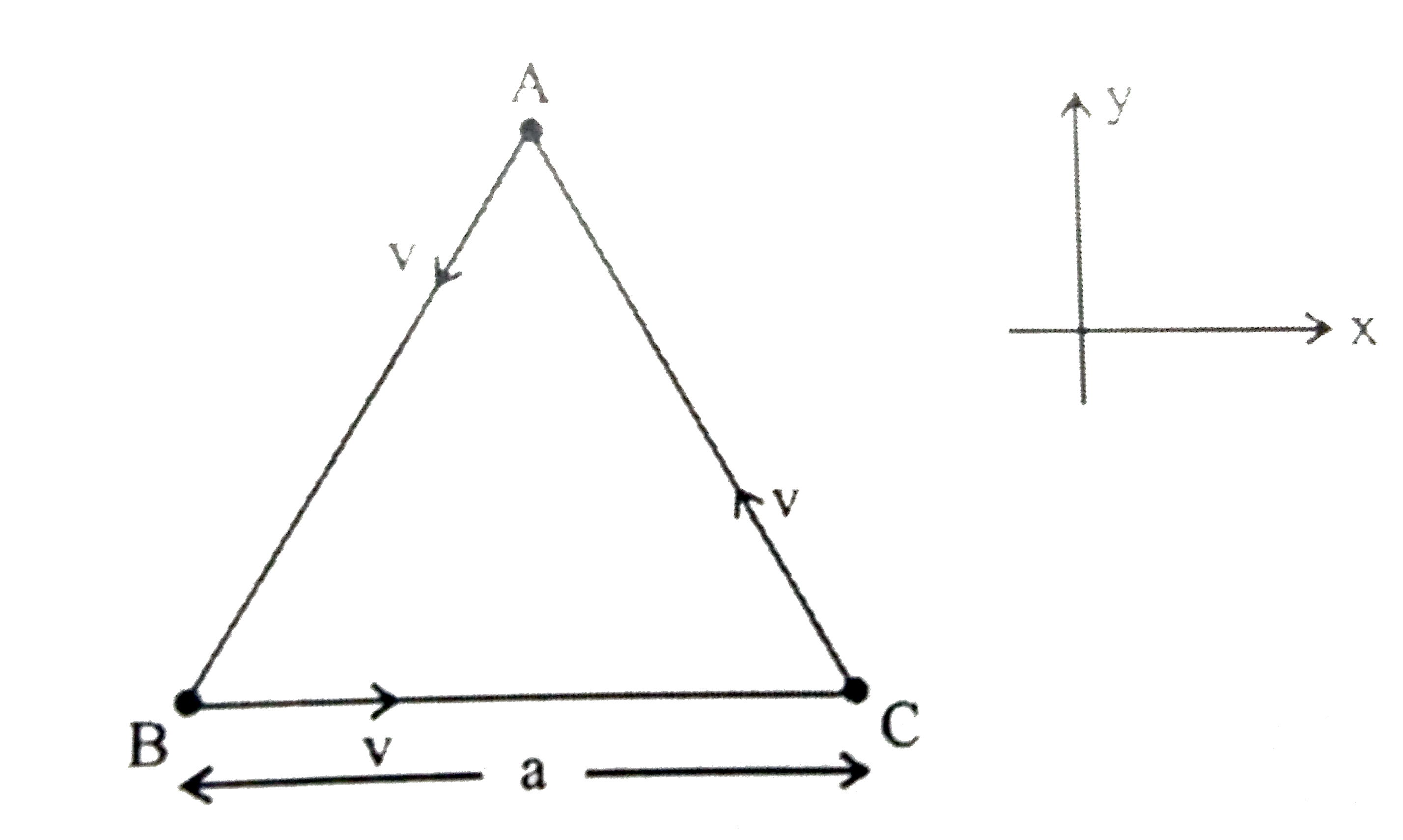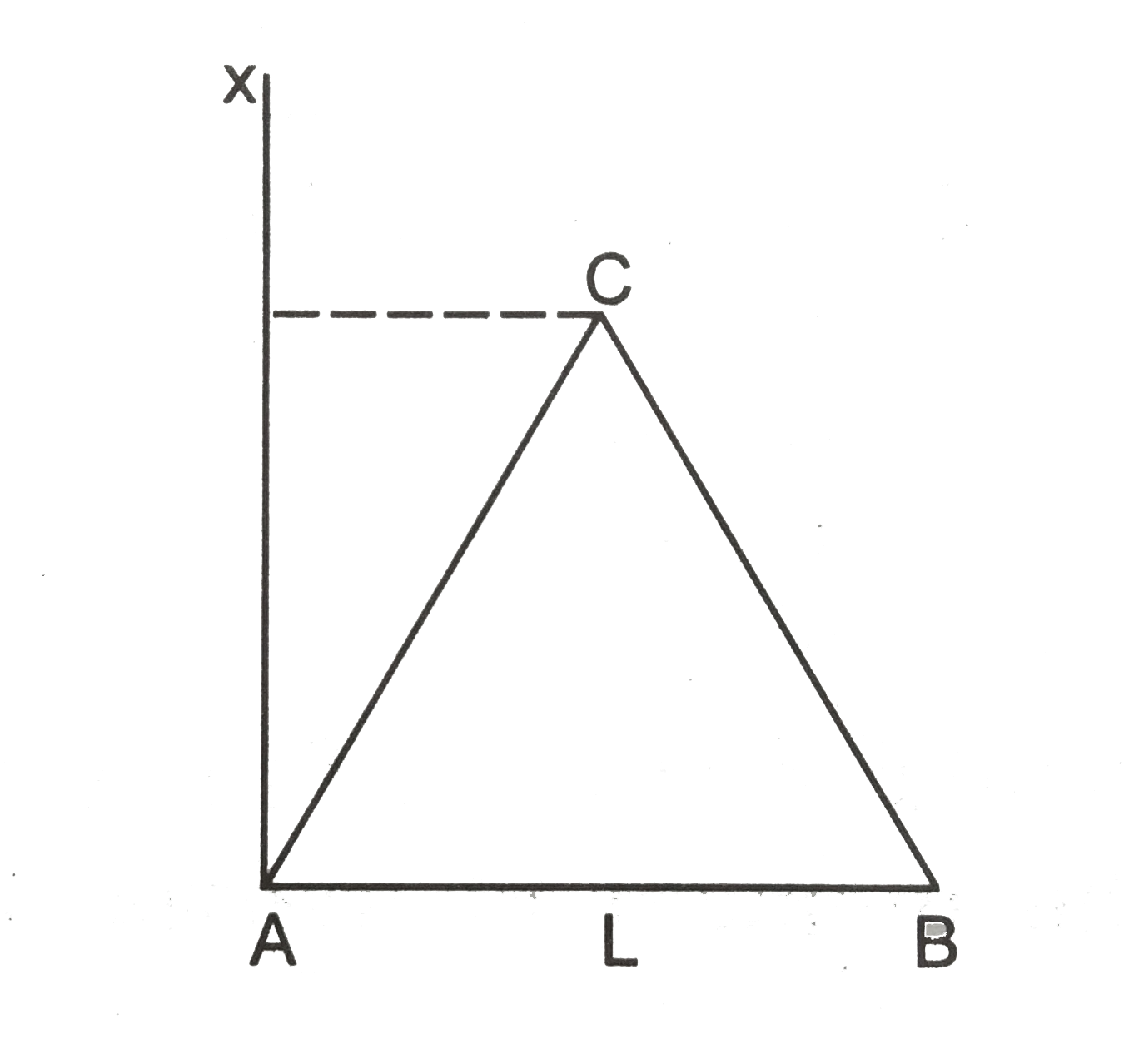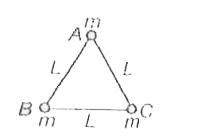Three particles A, B and C are situated at the vertices of an equilateral triangle ABC of side d at time t=0. Each of the particles moves with constant speed v. A always has its velocity along AB, B along BC and C along CA. At what time will the particles meet each other?
To solve the problem of when the three particles A, B, and C will meet, we can follow these steps:
1. Understanding the Motion of Particles:
- Particles A, B, and C are located at the vertices of an equilateral triangle ABC with side length d at time t=0.
- Each particle moves with a constant speed v:
- Particle A moves towards B along line AB.
- Particle B moves towards C along line BC.
- Particle C moves towards A along line CA.
2. Visualizing the Motion:
- As the particles move, they will always form an equilateral triangle, but the size of the triangle will decrease over time.
- The particles will eventually converge at the centroid of the triangle.
3. Finding the Velocity of Approach:
- Consider the approach between any two particles, say B and C.
- The angle between the direction of motion of B (towards C) and the line connecting B and C is 60∘ (since it's an equilateral triangle).
- The component of B's velocity towards C is v and the component of C's velocity towards B is vcos(60∘)=v2.
- Therefore, the total velocity of approach between B and C is:
vapproach=v+v2=3v2
4. Calculating the Time to Meet:
- The initial distance between the particles (the side of the triangle) is d.
- The time t taken for the particles to meet can be calculated using the formula:
t=DistanceVelocity of approach=d3v2=2d3v
5. Conclusion:
- The time at which all three particles will meet is:
t=2d3v
- Particles A, B, and C are located at the vertices of an equilateral triangle ABC with side length d at time t=0.
- Each particle moves with a constant speed v:
- Particle A moves towards B along line AB.
- Particle B moves towards C along line BC.
- Particle C moves towards A along line CA.
- As the particles move, they will always form an equilateral triangle, but the size of the triangle will decrease over time.
- The particles will eventually converge at the centroid of the triangle.
- Consider the approach between any two particles, say B and C.
- The angle between the direction of motion of B (towards C) and the line connecting B and C is 60∘ (since it's an equilateral triangle).
- The component of B's velocity towards C is v and the component of C's velocity towards B is vcos(60∘)=v2.
- Therefore, the total velocity of approach between B and C is:
vapproach=v+v2=3v2
- The initial distance between the particles (the side of the triangle) is d.
- The time t taken for the particles to meet can be calculated using the formula:
t=DistanceVelocity of approach=d3v2=2d3v
- The time at which all three particles will meet is:
t=2d3v
Topper's Solved these Questions
- REST AND MOTION : KINEMATICSBOOK - HC VERMA ENGLISHCHAPTER - REST AND MOTION : KINEMATICSEXERCISE - Objective -1
13 Videos
- REST AND MOTION : KINEMATICSBOOK - HC VERMA ENGLISHCHAPTER - REST AND MOTION : KINEMATICSEXERCISE - Objective -2
9 Videos
- REST AND MOTION : KINEMATICSBOOK - HC VERMA ENGLISHCHAPTER - REST AND MOTION : KINEMATICSEXERCISE - Question for short Answer
13 Videos
- PHYSICS AND MATHEMATICSBOOK - HC VERMA ENGLISHCHAPTER - PHYSICS AND MATHEMATICSEXERCISE - Question for short Answer
14 Videos
- ROTATIONAL MECHANICSBOOK - HC VERMA ENGLISHCHAPTER - ROTATIONAL MECHANICSEXERCISE - Questions for short Answer
21 Videos
Similar Questions
Four particles A,B,CandD are situated at the corner of a square ABCD of side a at t-0. Each of particles moves with constant speed (v). A always has its velocity along AB,B along BC,C along CD~andD along DA. At what time will these particles meet each other ?
View SolutionThree particles A, B, Care located at the comers of an equilateral triangle as shown in figure. Each of the particle is moving with velocity v. Then at the instant shown, the relative angular velocity of

View SolutionThree particles, each of mass m are situated at the vertices of an equilateral triangle ABC of side L as shown in the figure. Find the moment of inertia of the system about the line AX perpendicular to AB in the plane of ABC

View SolutionThree particles, each of mass m are situated at the vertices of an equilateral triangle ABC of side l (as shown in the figure).

The moment of inertia of the system about a line AX perpendicular to AB and in the plane of ABC, will be:
View SolutionThree particles, each of mass m are fixed at the vertices of an equilateral triangle of side length a. The only forces acting on the particles are their mutual gravitational forces. Then answer the following questions.

Force acting on particle C, due to particle A and B
View SolutionThree particles A,B and C each of mass m are lying at the corners of an equilateral triangle of side L . If the particle A is released keeping the particles B and C fixed , the magnitude of instantaneous acceleration of A is

View SolutionThree identical particles each of mass m are placed at the vertices of an equilateral triangle of side a. Fing the force exerted by this system on a particle P of mass m placed at the

(a) the mid point of a side
(b) centre of the triangle
View SolutionA particle moves with constant speed v along a circular path of radius r and completes the circle in time T. The acceleration of the particle is
View SolutionFind the centre of mass of three particle at the vertices of an equilateral triangle. The masses of the particle are 100g,150g,and200g respectively. Each side of the equilateral triangle is 0.5m along.
View SolutionThree identical particles are located at the vertices of an equilateral triangle. Each particle moves along a meridian with equal speed towards the centroid and collides inelastically. (a) all the three particles will bounce back along the meridians with lesser speed. (b) all the three particles will become stationary. (c) all the particles will continue to move in their original directions but with lesser speed (d) nothing can be said
View Solution
